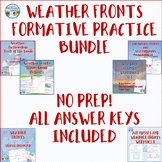

Very good resource for air masses. Students were able to use this resource to enhance their map skills as they learned about the different types of air masses.
— Michelle O. Rated 5 out of 5Good formative assessment for air fronts and weather lesson. I really liked the questions on the second page asking students to explain why a certain thing was happening.
Rated 5 out of 5 See all reviews
Are you looking for presentations and formative practice for your air masses and weather fronts lessons? This bundle is designed to give students a variety of ways to practice material related to air masses, weather fronts, and the weather at each front type. Lessons are ELL and Special Education
$11.60 Price $11.60 $14.50 Original Price $14.50 Save $2.90 View Bundle
Are you looking for some independent practice exercises for your earth science students? This worksheet reviews the basic properties of air masses and weather fronts. Students are asked to do matching, modeling and complete short answer questions related to activity along fronts.
Some of of my Atmosphere and Weather related materials that can accompany this assignment:
or you can check out all of my products online:
Total Pages Answer Key Teaching Duration 30 minutes Worksheets Report this resource to TPTReported resources will be reviewed by our team. Report this resource to let us know if this resource violates TPT’s content guidelines.
Analyze geoscience data to make the claim that one change to Earth’s surface can create feedbacks that cause changes to other Earth systems. Examples should include climate feedbacks, such as how an increase in greenhouse gases causes a rise in global temperatures that melts glacial ice, which reduces the amount of sunlight reflected from Earth’s surface, increasing surface temperatures and further reducing the amount of ice. Examples could also be taken from other system interactions, such as how the loss of ground vegetation causes an increase in water runoff and soil erosion; how dammed rivers increase groundwater recharge, decrease sediment transport, and increase coastal erosion; or how the loss of wetlands causes a decrease in local humidity that further reduces the wetland extent.